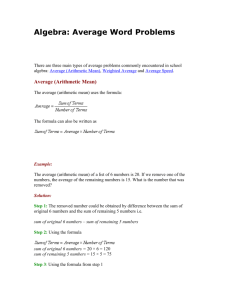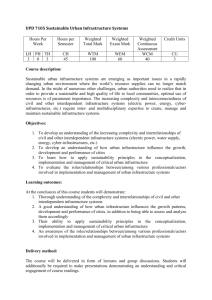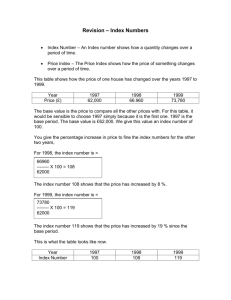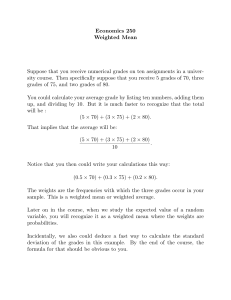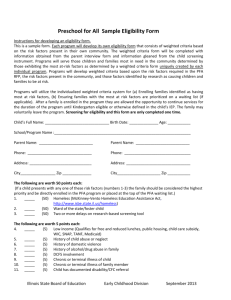Chapter 15: Weighted Average Length and Weighted Age
advertisement
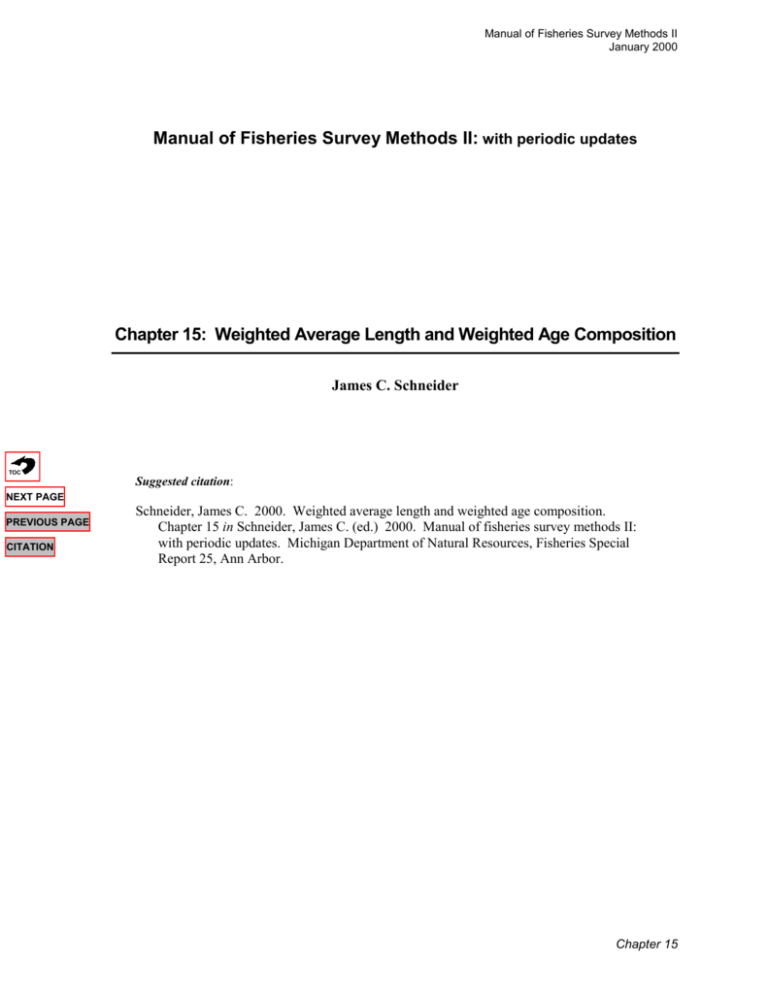
Manual of Fisheries Survey Methods II January 2000 Manual of Fisheries Survey Methods II: with periodic updates Chapter 15: Weighted Average Length and Weighted Age Composition James C. Schneider TOC Suggested citation: NEXT PAGE PREVIOUS PAGE CITATION Schneider, James C. 2000. Weighted average length and weighted age composition. Chapter 15 in Schneider, James C. (ed.) 2000. Manual of fisheries survey methods II: with periodic updates. Michigan Department of Natural Resources, Fisheries Special Report 25, Ann Arbor. Chapter 15 TOC NEXT PAGE PREVIOUS PAGE CITATION Manual of Fisheries Survey Methods II January 2000 Chapter 15: Weighted Average Length and Weighted Age Composition James C. Schneider Simple averages computed from subsamples stratified by size of fish usually give biased estimates of growth and age composition of fish populations. This bias can be eliminated by computing weighted averages with the aid of a length-frequency distribution representative of the population. In the example below, a large number of bluegills were captured by electrofishing. A length frequency was tabulated for the first 200 fish, and scale samples were taken from 20 of each inch group. The calculations show that simple averages tend to overestimate the average length of older, rarer, fish (e.g., 6.2 inches versus 5.8 inches for age 4), and to greatly distort the relative frequency of the various age groups (e.g., as much as 22%). Note that a bias may still exist in weighted averages due to gear size selectivity. Among young fish, the larger individuals are often more vulnerable to capture. In this example, both the length-frequency and the age-frequency information indicate that either the small age-1 fish were not fully vulnerable to the gear, or that the age-1 cohort was relatively weak and the age-2 cohort was relatively strong. TOC NEXT PAGE When recording average lengths on the FISH GROWTH form, indicate (on the appropriate blank) if a weighted method was used. PREVIOUS PAGE Sample aged CITATION Length group Length-frequency (inches) sample number (A) Ages present Number Percent (B) Average length (C) Relative number (A × B) 2.0 - 2.9 40 1 15 100.0 2.4 4,000 3.0 - 3.9 80 1 2 5 10 33.3 66.7 3.2 3.5 2,664 5,336 4.0 - 4.9 50 2 3 7 8 46.7 53.3 4.3 4.7 2,335 2,665 5.0 - 5.9 28 2 3 4 2 5 8 13.3 33.3 53.4 5.1 5.4 5.7 373 932 1,495 6.0 - 6.9 2 4 2 100.0 6.5 200 Weighted average length for an age group = sum of A × B × C ÷ A × B for relevant size groups: For age 1: 4000 × 2.4 + 2664 × 3.2 = 2.7 4000 + 2664 (Simple average = 2.6) For age 2: 5336 × 3.6 + 2335 × 4.3 + 373 × 5.1 = 3.9 5336 + 2335 + 373 (Simple average = 4.0) Chapter 15 1 Manual of Fisheries Survey Methods II January 2000 For age 3: 2665 × 4.7 + 932 × 5.4 = 4.9 2665 + 932 (Simple average = 5.0) For age 4: 1495 × 5.7 + 200 × 6.5 = 5.8 1495 + 200 (Simple average = 6.2) Weighted age-frequency for an age group = Sum of A × B for all relevant size groups: For age 1: 4000 + 2664 = 6,664 (33.3%) (Simple average = 26.7%) For age 2: 5336 + 2335 + 373 = 8,044 (40.2%) (Simple average = 25.3%) For age 3: 2665 + 932 = 3,597 (18.0%) (Simple average = 17.3%) For age 4: 1495 + 200 = 1,695 (8.5%) (Simple average = 30.7%) = 20,000 (100%) Total: TOC NEXT PAGE PREVIOUS PAGE CITATION Written 1980 by J. C. Schneider Chapter 15 2


